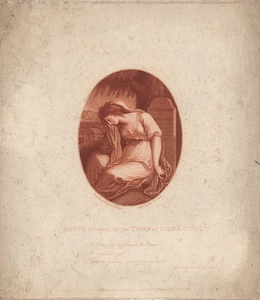| Method | Stipple |
| Artist | C. G. Playler after Angelica Kauffman |
| Published | London Published April 1. 1787 by Robert Wilkinson No.58 Cornhill. |
| Dimensions | Image 102 x 78 mm, Plate 223 x 200 mm, Plate 245 x 202 mm |
| Notes |
Text below image: If Virtue ire thy breast did move Ah pass not yet The feeling heart should tarry here. - Emma Corbett's Epitaph. A small stipple engraving depicting a personification of Virtue weeping at the grave of Emma Corbett, the titular character in Samuel Jackson Pratt's 1780 novel Emma Corbett: Or, the Miseries of Civil War. Founded on some recent circumstances which happened in America. The epistolary two-volume novel, originally published in 1780 and in its ninth edition by 1789, is a romance set against the backdrop of the American Revolutionary War. In the novel, Emma travels to America to find her love Henry who is fighting as a British soldier during the American Revolution. She disguises herself as a boy to make the journey by ship to America where she is captured by American rebels. She is later released on the orders of George Washington, impressed by her determination to be with her love. She eventually finds Henry but he has been wounded by a poison arrow, for which Emma sucks out the poison. Henry dies from his wounds and the fatally ill Emma, who poisoned herself in the process of attempting to save Henry, travels back to England where she dies in childbirth. Angelica Kauffmann (1741-1807) was a Swiss born Neoclassical painter and and etcher. She was escorted by her artist-father to study the Old Masters in the major Italian cities. Time spent with the English community in Rome convinced her to come to London in 1766 where she joined Sir Joshua Reynolds's social circle. Her reputation for portraiture and history painting led to her becoming a founder member of the Royal Academy. Condition: Creasing to sheet. Surface dirt to sheet. Some wear to the top left corner. |
| Framing | unmounted |
| Price | £125.00 |
| Stock ID | 53309 |

